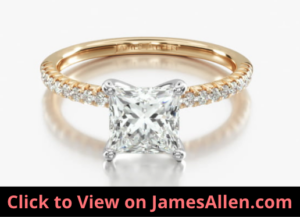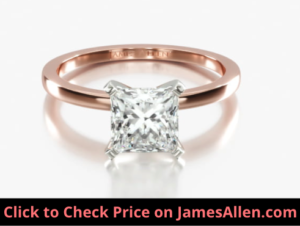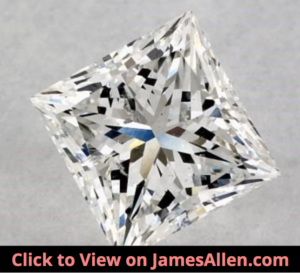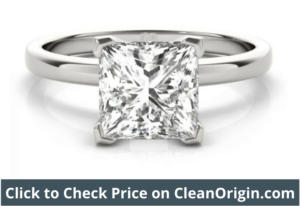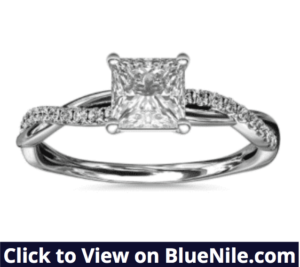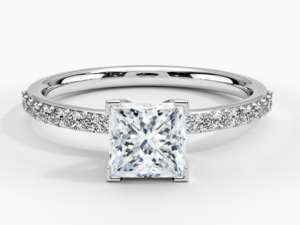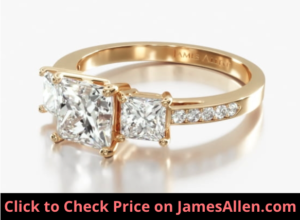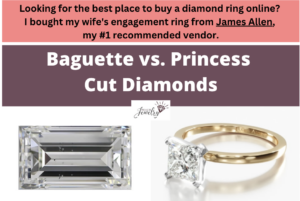
The cut of a diamond is one of your most important initial decisions. There’s the popular round brilliant everyone recognizes as a staple for diamond rings, but there are also alternatives to that traditional style.
Two of those choices are baguette and princess cuts.
The main difference between baguette and princess cuts is baguettes have elongated, step-cut facets that stretch across its rectangular outline. Princess cuts have triangular-shaped brilliant facets and a squarish overall shape that produce more white light.
Let’s compare baguette versus princess cut diamonds and what you should know about each, including their brilliance, clarity, durability, and more.
What is a Baguette Cut Diamond?
Baguette cut diamonds are distinguished from other cuts by its long, rectangular shape.
It’s a step-cut, which means its facets are lengthy and mimic a set of stairs that narrow as they reach the center of the diamond.
Check out the high-resolution image below of a baguette cut.
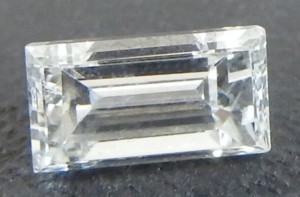
Notice how the facets run parallel across the stone and how its corners are squared off.
Most have longer lengths than widths, where the length is two to four times its width. Others are closer to a square shape, with a ratio of 1.5:1.
It’s possible to find baguette cuts as the center diamond in an engagement ring, but their lack of brilliance usually puts them in the position of an accent that surrounds the main diamond.
What is a Princess Cut?
Princess cuts are also known as a “square modified brilliant” because of its squarish or rectangular shape with sharp corners that still maximizes brilliance.
Here’s an example of one on an engagement ring.
The V-prongs on each corner highlight its distinct shape and cover each of the sharp corners.
Princess cuts often have 57 or 58 facets, which means there’s plenty of surface area for light to bounce in and around the diamond.
Developed in the 1960s, they’ve grown in popularity since the 1980s.
It offers an alternative to the round cut while not sacrificing too much in the areas of sparkle, clarity, and color.
How are Baguette and Princess Cuts Different?
Number and Shape of Facets
The way facets are cut on a diamond determine its overall shape.
They’re the surfaces on a diamond that capture and reflect light, so their shape and sharpness impact brilliance.
Baguette cuts generally have 14 facets. For princess cuts, it’s 57 or 58.
It’s not only the number that’s different.
The facets on baguettes are rectangular, and many are long enough to stretch across most of the diamond.
This shape creates a smooth surface, where the naked eye can often view each individual facet. If it’s large enough, you can run your finger across individual facets.
The brilliant cut facets on a princess cut are a different shape compared to baguette cuts. Instead of elongated facets, most are triangles.
They’re difficult to identify at the individual level, but here’s an image of a princess cut in high resolution.
If you view it on the vendor’s website, you can rotate the image to explore every angle and better spot the distinct facets.
On a typical princess cut, there are 21 on the crown, 33 on the pavilion, and four on the girdle.
Some variations include only 25 on the pavilion, but these differences aren’t noticeable to the naked eye.
Each facet on a princess cut is much smaller compared to baguettes.
The difference in the number of facets between the two remains the same even if the diamonds are the same weight.
Brilliance
An advantage of princess cuts is they exhibit more brilliance than baguette cuts.
This is because princess diamonds are a brilliant cut, which is designed to enhance light performance. Baguette cuts are a step-cut.
The facets of a princess cut are designed in a way that allows light to properly enter, bounce around, and exit at nearly every angle.
No matter their shape or cut, diamonds collect light at every angle, but it’s the quality of the cut that determines how well that light is reflected back to the viewer.
Round brilliant cuts have the strongest brilliance, but princess cuts are next in line.
Baguette cuts have low brilliance because of their elongated facets. They pale in comparison to the performance of triangular or kite-shaped facets.
When you twirl around a baguette, you won’t see as much light returning from the diamond, even if it’s a quality cut. Instead, it creates a flash of light, known as a “hall of mirrors” effect.
Its light performance is also described as a warm glow.
Clarity
Clarity refers to the amount of inclusions visible in a diamond, such as bruises, feathers, or twinning wisps. Its graded on a scale developed by the Gemological Institute of America (GIA) that ranges from flawless to I3.

A diamond with visible inclusions will earn a lower clarity grade than one that’s eye-clean.
The princess cut below earned an I1 clarity grade, which is on the low end of the GIA scale.
The difference in clarity between baguette and princess cuts is a result of their brilliance and the way facets are cut.
Stronger light performance has the potential to hide inclusions, so a high clarity grade can sometimes be a substitute for clarity.
When you view a princess cut, you’ll see light reflecting off it.
This can hide dark marks or blemishes within the diamond. On the other hand, baguette cuts don’t display the same amount of light. There’s less reflection to hide any inclusions.
Most buyers want a diamond that’s eye-clean. If you’re considering a princess cut, an SI1 clarity grade is often a safe place to start for diamonds around one carat, like this lab-created one.
For a baguette cut, opt for one with a clarity grade higher than SI1 to improve the chances inclusions aren’t visible.
Color
Colorless diamonds are more valuable than ones with a yellow or brown tint.
While color is a separate category from cut, clarity, and brilliance, there is some overlap. When a diamond has a strong light performance, it can hide color.
For example, the lack of brilliance in a baguette cut means it doesn’t hide color as well as princess cuts.
Notice how intense the shades of yellow are in the baguette cut below.
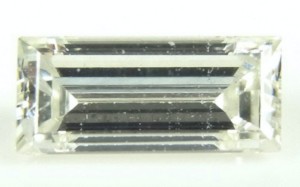
Similar to clarity, color is graded on a scale created by the GIA that ranges from D to Z. D color diamonds are colorless, and Z shows strong yellow or brown.
If you want a baguette cut diamond that looks colorless to the naked eye, consider at least a G color grade. It’s the highest grade that still falls into the “near colorless” range.
For a princess cut to have this same effect, choose at minimum an H color grade.
The yellow tint will only show under magnification.
The improved brilliance of a princess cut compared to a baguette allows you to save money with a lower color grade that still appears colorless.
Prices
The price per carat of a baguette cut diamond is less expensive than a princess cut. There is less demand for baguette diamonds, and they often have lower-quality cuts.
The price of a baguette diamond depends on its grades across the four Cs of color, cut, clarity, and carat. This is true of all other cuts as well.
The price of a princess cut also depends on the retailer. For example, let’s consider a diamond from online jewelry retailer James Allen with the following grades:
- Carat: 1.00
- Color: G
- Cut: Very good
- Clarity: VS1
This is a quality diamond, but it avoids the premiums that results from the highest grades. The average price for this diamond is $4,050, with a range of $3,400-$4,770.
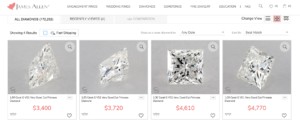
As another example, let’s examine the prices of the same diamond from Blue Nile.
At that retailer, it costs an average of $5,159, with a range from $4,345-$6,113.
That places princess cuts below the price of traditional round cuts but more than most baguettes.
Popularity in Engagement Rings
Princess cuts fall behind round cuts in terms of popularity.
Brilliance is the prized characteristic for the diamond in an engagement ring, so buyers often decide on round or princess diamonds because they’re brilliant cuts.
Princess cuts offer the balance between affordability and light performance. They’re also used as accents, either complementing another princess cut or a different shape as the main diamond.
Baguette diamonds are rarely used as the center gem.
Instead, it’s most often seen as an accent on the shank, surrounding the main diamond on each side. Specifically, tapered baguettes have sides that angle in, so one width is longer than the other.
I’ve posted an image below of an engagement ring with tapered baguettes.
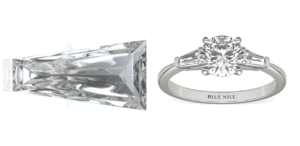
On the left is a close-up view of the baguette.
A three-stone ring with tapered baguettes is the most popular design using these diamonds.
In fact, it’s difficult to find loose baguette diamonds, and most retailers don’t sell them.
Instead, they sell emerald cuts, which are a close relative. The distinction is the corners are beveled instead of squared.
Durability
When comparing the durability of princess versus baguette cuts, the most important aspect is their sharp corners. Each of their four corners are more prone to chipping than those of other cuts such as round diamonds.
The best way to protect them is with the right setting. Bezel settings provide the strongest protection, but prongs are a more popular way to hold a diamond because it exposes more of its table.
The princess cut engagement ring below uses four traditional prongs to hold each corner.
Another option is V-prongs because they’re designed to hold its sharp corners.
To illustrate, here’s an example of a princess cut with V-prongs.
As with any cut, avoid wearing princess or baguette diamonds during physical activity.
Not only are the diamonds prone to breaking, but the prongs can bend backward and loosen their grip.
What do Baguette and Princess Cuts Have in Common?
Sharp Corners
The first quality baguettes and princess cuts have in common is sharp corners, which contrast with the rounded edges of many other cuts.
Examples include Asscher, heart, and cushion cut diamonds. If you run your finger along those cuts, you’ll feel a smooth edge. Baguette and princess cuts are pointy on the sides.
Whether it’s a positive or negative trait is a subjective judgement. When placed in a proper setting, I find the design provides a sense of elegance not found in ones with rounded edges.
Place examples of both styles side-by-side to learn which you prefer.
Often Used as Diamond Accents
Secondly, princess and baguette cuts are frequently used as accents. There are an endless number of ring designs and how you can place diamonds around the shank.
Many buyers choose a solitaire setting, but adding more diamonds can increase the total carat weight of the piece and add sparkle for a lower price than increasing the size of the main diamond.
Whether it’s one tapered baguette on each side, multiple princess cuts forming a halo, or several cascading down each side of the ring, you can have these cuts on your ring even if it’s not the most prominent part.
For example, here’s a three-stone setting, where two princess cuts surround another one in the middle.
You can even combine the two cuts, with the princess diamond in the middle surrounded by tapered baguettes.
Should You Choose a Princess or Baguette Cut?
Baguette and princess cuts can both create a stunning ring.
Here are some guidelines for choosing between the two.
Consider a baguette cut if:
- You plan to use them as accents to flank the main diamond, especially in a channel set ring
- You desire a unique center gem and aren’t concerned about brilliance
- You’re choosing an eternity ring, where baguette diamonds will circle all the way around
A princess cut might be right for you if:
- Affordability is important, but you don’t want the diamond to lack brilliance
- You’re looking for an alternative to the popular round cut diamond
- You want accents that are distinguished from the main gem
Explore several options for both princess and baguette cut diamonds, and view them either in-person at a jewelry retailer or in high-quality photos online.
By understanding the differences between princess and baguette cuts, you can select the right diamond for your new ring and have confidence in that decision.

Jacob Clarke
Jacob Clarke is the founder of TeachJewelry.com.
He earned an Applied Jewelry Professional Diploma from the Gemological Institute of America (GIA) and now brings you essential information about diamonds, settings, and more.
Jacob has consulted with leading jewelry brands, and his work has been cited in Clean Origin, Diamond Nexus and industry publications.
He's also a member of the International Gem Society.
He enjoys discussing jewelry with readers, so contact him with any questions at jacob.clarke@teachjewelry.com.

